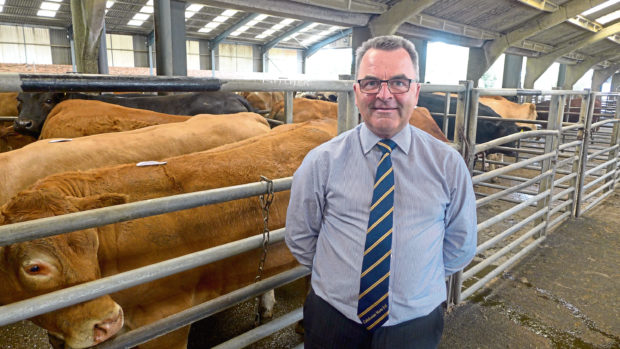Is the biggest failing of the red meat sector, and probably the wider farming industry, the fact that most farmers do not actually sell the end product?
The problem – and we at Caledonian Marts are just as guilty of it as most others in the red meat chain – is that we all try very hard to be really good at what we do in our own individual segments of the chain, and very few of us raise our heads from the daily chores of stockmanship to question how they could sell a steak pie to a school lunch procurement manager.
Many farmers think their job is done when they load beasts on to a wagon to leave the farm.
Thereafter, responsibility is passed to the haulier, to the mart team, to the abattoir and finally the meat is prepared and expertly presented by the butcher.
Red meat sales have fallen something like 6% across the UK in the past six months.
I won’t waste words highlighting the reasons why this is the case, but instead point out that it is time to step up to the plate and fight back.
But who along that chain takes responsibility for really selling the meat?
Most Scottish farm produce ends up on supermarket shelves. The main aim of a supermarket is to earn the maximum possible return for every square metre of floor or shelf space. They do this by supplying the goods that consumers want at the optimum price.
Supermarket bosses get excited when goods “fly off the shelves” – so if something, eg Quorn, starts to demand more shelf space, then more shelf space it shall have; likewise, if red meat is in less demand, then butcher counters and shelf space becomes squeezed.
This is just a roundabout way of pointing out that even supermarkets, who we entrust to sell our final product, are not interested in actually selling it if they can make a better return from devoting more of their costly shelf space to something in higher demand.
So, what about the meat wholesalers, those who stand in the ring or visit our farms to buy our stock, then carefully butcher it to the supermarket specifications – is it their job to sell our meat and our industry to the public?
Some of them do take that leap; if they have a strong brand name, they may invest in advertising and public relations campaigns in the hope of persuading the consumer that their meat is best.
However, most meat packers exist in a highly competitive segment of the chain, where throughput is key and sticking a supermarket label on the packs is what pays the bills – dealing with generic beef/lamb/pork gives no incentive for marketing efforts.
The key to marketing, as I see it, is building a recognisable brand.
Once a brand is in place, and marketing efforts around that brand have raised awareness, then it should be game on for sell, sell, sell!
We are extremely lucky in Scotland. We have built the recognisable brands of Scotch Lamb and Scotch Beef. But are we doing enough, across the industry to sell the products to the consumer?
How would the meat efforts measure up against Scotch Whisky or the fast-growing demand for Scottish salmon?
Someone, or somebody needs to urgently get beef and sheep farmers around the table and work out how we can increase efforts to sell our story, sell our stock and sell our meat.
I have no doubt that QMS and others will say they are doing their very best – but is even that good enough? Can it be done better?
It feels sometimes as though we are at war against the forces of veganism and environmentalism, but are we just fighting an inferno with a water pistol?
John Kyle is MD at Caledonian Marts, Stirling.










